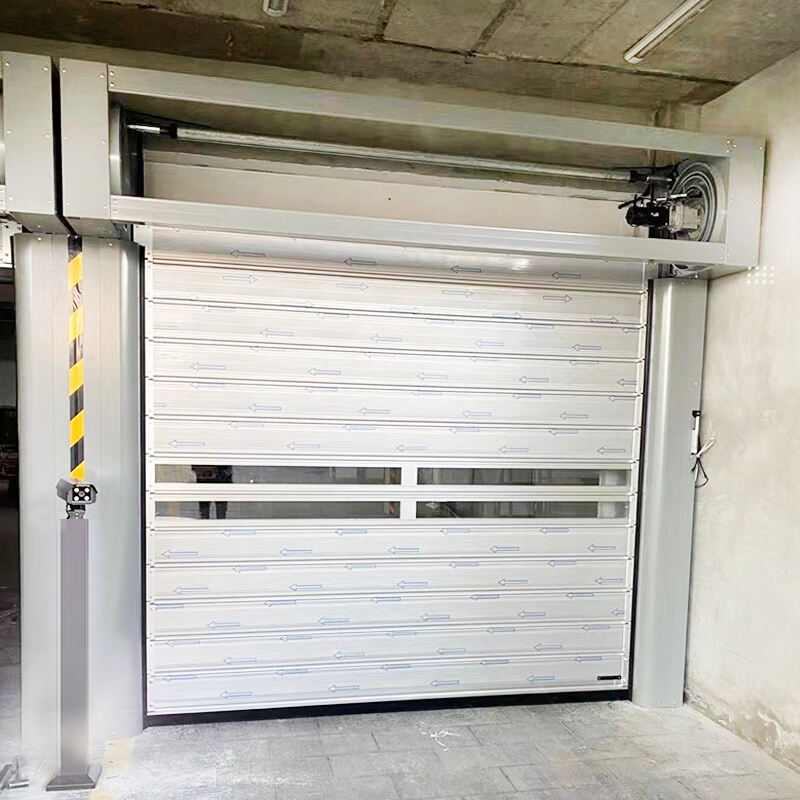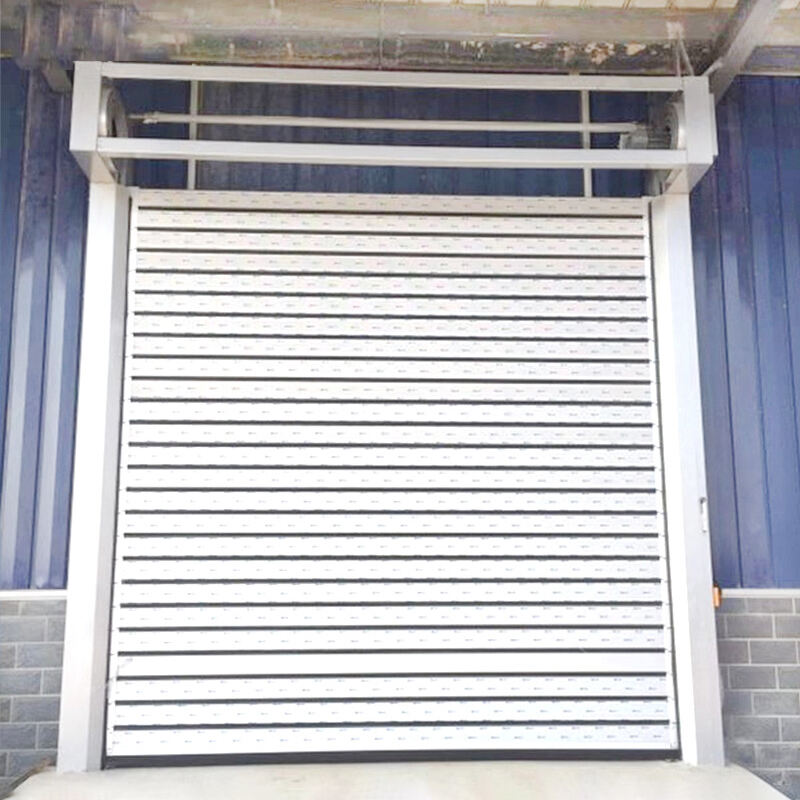Обзор встроенных технологий безопасности
Скоростные двери сочетают в себе машиностроение, сенсорные системы, логику управления и материаловедение для защиты людей, продукты и процессы. Почему во многих учреждениях предусмотрены расширенные опции безопасности для этих дверей? Потому что двери высокой скорости работают с такими скоростями, которые требуют быстрого, надежного обнаружения и предсказуемого поведения. Правильно интегрированные технологии безопасности снижают количество аварий, предотвращают повреждения и обеспечивают бесперебойную работу. В данном обзоре объясняются основные технологии, commonly используемые в дверях высокой скорости, и то, как они взаимодействуют друг с другом, чтобы создать многоуровневую защиту. Все чаще операторы ожидают, что двери будут предоставлять данные и диагностику в рамках стратегии безопасности, превращая пассивные барьеры в активные, контролируемые активы.
Системы обнаружения присутствия
Фотоэлектрические барьеры и световые завесы
Фотоэлектрические барьеры и световые завесы формируют основной уровень обнаружения для Скоростные двери . Эти системы излучают инфракрасные лучи через проем, чтобы любое прерывание немедленно вызывало остановку или обратный ход. В зонах с интенсивным движением световые завесы могут обнаруживать небольшие вторжения пешеходов, которые могут быть пропущены напольными датчиками, и делают это без физического контакта, сохраняя пропускную способность и обеспечивая безопасность работников. Регулярная калибровка и очистка этих датчиков важны для обеспечения надежности, особенно в пыльных или влажных помещениях.
Радары и микроволновые датчики движения
Радарные и микроволновые датчики обеспечивают надежное обнаружение присутствия и менее чувствительны к пыли, изменению освещенности или загрязнению. Эти датчики могут обнаруживать приближающиеся транспортные средства и движущееся оборудование до того, как они пересекут проем, позволяя высокоскоростным дверям заранее реагировать и избегать резкой остановки при активных нагрузках. Радар также поддерживает обнаружение на более длинных дистанциях, что помогает согласовывать работу дверей с вышестоящими конвейерами и приближением транспорта. Комбинация радарных и оптических датчиков обеспечивает надежный набор функций обнаружения, устойчивый к изменениям окружающей среды.
Краевые и контактные средства безопасности
Мягкие нижние кромки и ограничение усилия
Мягкие или гибкие нижние кромки в сочетании с приводами с ограничением усилия защищают людей и оборудование от травм сдавливания. Когда нижняя кромка сталкивается с препятствием, система определяет нагрузку и выполняет безопасное обратное движение или контролируемую остановку. Эта технология особенно ценна на объектах, где вблизи высокоскоростных дверей одновременно присутствует пешеходное и автопогрузчиковое движение. Регулярное тестирование отклика кромки обеспечивает постоянное соответствие порогам безопасности и предотвращает снижение эффективности со временем.
Разрушаемые планки и ударопрочные шторы
Разрушаемые планки и материалы штор, устойчивые к воздействию ударов, предотвращают структурные повреждения в результате столкновений. Спроектированные так, чтобы отсоединяться или деформироваться при определенных уровнях усилия, эти элементы позволяют двери быстро возобновить работу после удара. Для загруженных погрузочных площадок или узких проходов такие особенности уменьшают время простоя и сохраняют безопасную зону вокруг высокоскоростных дверей. Также часто применяются простые процедуры сброса, позволяющие персоналу быстро и безопасно восстановить сломанные соединения.
Передовые системы обнаружения и резервирования
Напольные коврики, датчики давления и индукционные петли
Датчики на полу и индукционные петли обеспечивают локализованное обнаружение, дополняя оптические и радарные системы. Коврики с датчиками давления обнаруживают медленно движущиеся или неподвижные объекты, которые могут быть не замечены верхними лучами, а петли определяют наличие металла в транспортных средствах, чтобы предотвратить преждевременное закрытие. Комбинирование этих сигналов предоставляет высокоскоростным дверям несколько независимых способов обнаружения опасности. Также необходимы регулярные проверки датчиков на полу, чтобы избежать сбоев из-за износа или накопления посторонних предметов.
Логика голосования и объединения данных с датчиков
Фузионирование датчиков и логика голосования повышают надежность, требуя согласия между различными типами датчиков, прежде чем разрешить опасное действие. Например, система может требовать подтверждения радаром и непрерывного светового барьера для разрешения быстрого закрытия. Такая избыточность уменьшает ложные срабатывания и пропуски, обеспечивая стабильное поведение высокоскоростных дверей даже в сложных условиях. Инженерные команды часто настраивают пороги голосования во время ввода в эксплуатацию, чтобы соответствовать специфическим для площадки паттернам движения.

Системы управления и безопасное проектное исполнение
Резервные контроллеры и режимы безопасной остановки
Современные высокоскоростные двери оснащены резервными контроллерами и четко определенным безопасным поведением при остановке для безопасного управления неисправностями. Если контроллер выходит из строя, его функции берет на себя резервный контроллер, который приводит дверь в предсказуемое состояние, снижая риск неконтролируемого движения. Определенные режимы безопасной остановки упрощают восстановление после неисправностей и обеспечивают безопасность персонала, работающего с высокоскоростными дверями или в их непосредственной близости. Обновления программного обеспечения, критичного для безопасности, должны тщательно управляться, чтобы избежать возникновения регресса.
Аварийный Стоп, Блокировка И Блокировка Совместно С Другим Оборудованием
Цепи аварийного стопа, средства блокировки и блокировки совместно с другим оборудованием предотвращают опасные одновременные действия. Блокировки могут остановить движение двери до тех пор, пока оборудование на предыдущем этапе не будет безопасным, либо пока транспортное средство полностью не освободит проем. Эти функции управления необходимы для интеграции высокоскоростных дверей в автоматизированные производственные линии и логистические коридоры. Хорошо документированные процедуры блокировки и маркировки обеспечивают безопасность техников во время технического обслуживания и ремонта.
Технологии Видимости И Предупреждения
Светодиодные индикаторы и стробоскопы
Высокая видимость светодиодных индикаторов и стробоскопов позволяет операторам вблизи передавать статус дверей. Визуальные сигналы критически важны в шумных помещениях, где звуковые сигналы могут остаться незамеченными. Правильно расположенные индикаторы уменьшают путаницу у скоростных дверей, сигнализируя о предстоящем движении и безопасных зонах прохода. Цветовое кодирование и фазированная последовательность освещения могут дополнительно уточнить оперативное состояние для операторов и водителей.
Звуковые сигналы и голосовые объявления
Звуковые сигналы и голосовые объявления предоставляют дополнительные предупреждения, информирующие персонал о предстоящих циклах дверей. Настраиваемые интервалы предварительного оповещения могут дать сотрудникам достаточно времени для освобождения проема, что повышает безопасность, не замедляя чрезмерно операции вокруг высокоскоростных дверей. Уровень громкости и тональность следует настроить так, чтобы избежать привыкания к тревогам, оставаясь при этом различимыми на фоне окружающего шума.
Аварийная работа и устойчивость к перебоям в подаче электроэнергии
Резервный аккумулятор и ручное управление
Резервные аккумуляторные блоки и ручные механизмы управления обеспечивают безопасную работу во время отключения электроэнергии. Аккумуляторы позволяют выполнить ограниченное количество циклов для эвакуации персонала или перемещения важных грузов, а ручное управление обеспечивает контролируемый доступ при отключенной автоматике. Эти функции обеспечивают безопасность людей и процессы возле высокоскоростных дверей во время непредвиденных перебоев. Командам технического обслуживания следует периодически проверять состояние аккумуляторов, чтобы убедиться в их готовности.
Интеграция противопожарных и дымозащитных систем
Некоторые высокоскоростные двери оснащены огнестойкими полотнами и автоматическими механизмами закрывания, связанными с системами обнаружения пожара. Интеграция с системами управления дымом и протоколами аварийного выхода гарантирует, что двери способствуют безопасности здания, а не препятствуют ей, обеспечивая баланс между высокой пропускной способностью и требованиями безопасности. Согласование с системами отопления, вентиляции и кондиционирования, а также системами контроля дыма критически важно для предотвращения непреднамеренного удержания дыма или замедления эвакуации.
Механические защиты и прочность
Надежные системы привода и тормозные механизмы
Промышленные приводные двигатели, усиленные ремни или цепи и самоблокирующиеся тормоза уменьшают вероятность неконтролируемого движения. Высокоскоростные двери должны оставаться управляемыми при высоком количестве циклов, а прочные механические системы минимизируют внезапные поломки, которые могут создать опасность в районе проемов. Регулярная смазка и проверка крутящего момента продлевают срок службы компонентов и обеспечивают предсказуемую работу высокоскоростных дверей.
Устройства против падения и вторичные системы удержания
Устройства против падения и вторичные удерживающие ремни предотвращают обрушение полотна двери в случае выхода из строя основных крепежных элементов. Эти меры защищают персонал, который может находиться под открытой или частично закрытой дверью, обеспечивая дополнительный уровень безопасности для высокоскоростных дверей. В ходе проверок необходимо учитывать момент затяжки крепежа и целостность удерживающих ремней в рамках регулярных проверок безопасности.
Данные, диагностика и прогнозирование безопасности
Телеметрия IoT и удаленная диагностика
Телеметрия в сети предоставляет данные в реальном времени о количестве циклов, токе двигателей и состоянии датчиков для высокоскоростных дверей. Удаленная диагностика помогает службам технического обслуживания выявлять компоненты, состояние которых ухудшается, до их выхода из строя, снижая вероятность возникновения критических неисправностей во время работы. Телеметрия также поддерживает аналитику на уровне всего парка дверей для объектов, где установлено множество высокоскоростных дверей.
Предиктивное техническое обслуживание и оповещения
Предиктивные алгоритмы анализируют телеметрию для прогнозирования сбоев и планирования окон технического обслуживания. Предиктивное обслуживание снижает незапланированное время простоя и сохраняет безопасность высокоскоростных дверей за счёт своевременной замены изношенных деталей. Оповещения могут перенаправляться на мобильные устройства, обеспечивая быструю реакцию на возникающие проблемы и минимизируя небезопасные условия эксплуатации.
Интерфейсы человек-машина и поддержка обучения
Интуитивно понятные HMI и системы контроля доступа
Интерфейсы человеко-машинного взаимодействия (HMI) отображают состояние, диагностические данные и средства управления в удобном для восприятия формате. Средства контроля доступа обеспечивают возможность изменения параметров безопасности или выполнения ручных команд только квалифицированным персоналом, предотвращая вмешательство в работу высокоскоростных дверей со стороны неквалифицированных пользователей. Интерфейсы HMI часто включают экраны блокировки и журналы аудита для отслеживания изменений и обеспечения безопасной эксплуатации.
Режимы обучения и функции моделирования
Некоторые передовые контроллеры включают режимы обучения и функции моделирования, которые позволяют техническому персоналу проверять настройки без перемещения полотна двери в обычном режиме. Эти функции уменьшают количество ошибок при вводе в эксплуатацию и способствуют более безопасной настройке высокоскоростных дверей. Обучающие симуляции могут воспроизводить распространенные неисправности, чтобы подготовить персонал к устранению реальных проблем.
Адаптация к окружающей среде и специализированные технологии
Датчики для низких температур для холодильных камер
Холодильные версии высокоскоростных дверей используют датчики и нагревательные элементы, устойчивые к низким температурам, чтобы избежать ложных срабатываний и образования льда. Специализированные уплотнения и подогреваемые края обеспечивают безопасную эксплуатацию в условиях морозильных камер, где стандартные датчики вышли бы из строя. Также в протоколах эксплуатации учитываются средства индивидуальной защиты работников и сцепление с полом при выборе датчиков для высокоскоростных дверей.
Компоненты, совместимые с чистыми помещениями
Для фармацевтической и полупроводниковой промышленности применяются материалы, не выделяющие частицы, корпуса с уплотнением и бесконтактные датчики, обеспечивающие чистоту и безопасность. Высокоскоростные двери, предназначенные для чистых помещений, не производят частиц и сохраняют ламинарный поток, соответствуют строгим требованиям по контролю загрязнений.
Стандарты, сертификация и соответствие требованиям
Испытания в независимых лабораториях и сертификация CE, UL
Продукция часто проходит испытания в независимых лабораториях и имеет сертификаты, такие как CE или UL, подтверждающие заявленную безопасность. Высокоскоростные двери с сертификацией имеют документально подтвержденные результаты испытаний на устойчивость к воздействию, надежность датчиков и электробезопасность, что поддерживает процессы закупки и соответствия нормативам. Запрос отчетов об испытаниях помогает убедиться, что высокоскоростные двери соответствуют конкретным метрикам безопасности, необходимым для проекта.
Соответствие местным нормам и отраслевым рекомендациям
Соблюдение местных строительных норм и отраслевых рекомендаций гарантирует, что высокоскоростные двери соответствуют минимальным требованиям безопасности для конкретных применений. Указание требований норм в технических спецификациях снижает риск повторного проектирования и необходимости модернизации во время установки, а также избегания дорогостоящих несоответствий, которые могут повлиять на безопасность.
Лучшие практики монтажа и ввода в эксплуатацию
Профессиональный монтаж и функциональное тестирование
Правильная установка и ввод в эксплуатацию имеют критическое значение для обеспечения надлежащего функционирования встроенных технологий безопасности. Проверка функциональности датчиков, блокировок и режимов аварийного состояния подтверждает корректное взаимодействие высокоскоростных дверей с технологическими процессами на объекте. Протоколы ввода в эксплуатацию часто включают сценарии испытаний и критерии приемки для систем безопасности.
Документация по фактическому исполнению и обучение при передаче
Предоставление документации по фактическому исполнению, финальных настроек и проведение практического обучения при передаче объекта гарантирует, что персонал ознакомлен с системами безопасности. Четкие записи упрощают последующие аудиты и обслуживание высокоскоростных дверей, а также помогают поддерживать стабильные параметры безопасности при смене персонала.
Часто задаваемые вопросы
Типовые технологии безопасности, применяемые в промышленных высокоскоростных дверях
К распространенным технологиям относятся световые завесы, радарные датчики, напольные датчики давления, мягкие края, резервные контроллеры, резервное батарейное питание и диагностика через интернет вещей (IoT) для высокоскоростных дверей.
Как эти технологии снижают вероятность аварий и простоев
Многоуровневое обнаружение, логика голосования и прогнозирующее обслуживание позволяют выявлять угрозы на ранних этапах и предотвращать опасное движение дверей, что снижает количество инцидентов и перебоев в работе высокоскоростных дверей.
Какие сертификаты следует запрашивать при покупке дверей
Запрашивайте сертификаты CE, UL или эквивалентные сертификаты, отчеты независимых испытательных лабораторий о тестировании на ударную стойкость и безопасность, а также документы, подтверждающие соответствие местным строительным нормам для высокоскоростных дверей.
Как часто следует проверять и тестировать системы безопасности
Ежемесячные функциональные проверки и ежегодные комплексные инспекции являются минимальными требованиями; увеличьте их частоту в случае эксплуатации в условиях высокой интенсивности, пыли или коррозионной среды, где высокоскоростные двери работают в усиленном режиме.
Содержание
- Обзор встроенных технологий безопасности
- Системы обнаружения присутствия
- Краевые и контактные средства безопасности
- Передовые системы обнаружения и резервирования
- Системы управления и безопасное проектное исполнение
- Технологии Видимости И Предупреждения
- Аварийная работа и устойчивость к перебоям в подаче электроэнергии
- Механические защиты и прочность
- Данные, диагностика и прогнозирование безопасности
- Интерфейсы человек-машина и поддержка обучения
- Адаптация к окружающей среде и специализированные технологии
- Стандарты, сертификация и соответствие требованиям
- Лучшие практики монтажа и ввода в эксплуатацию
- Часто задаваемые вопросы

